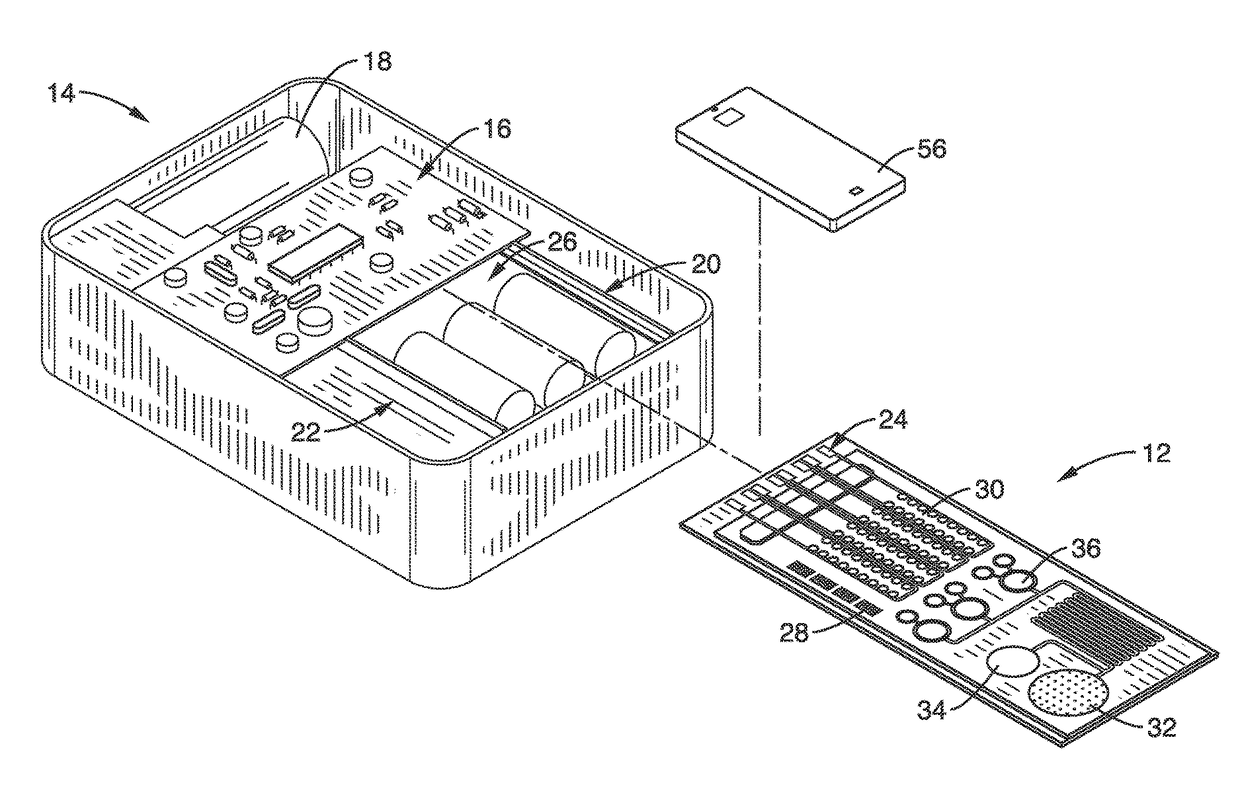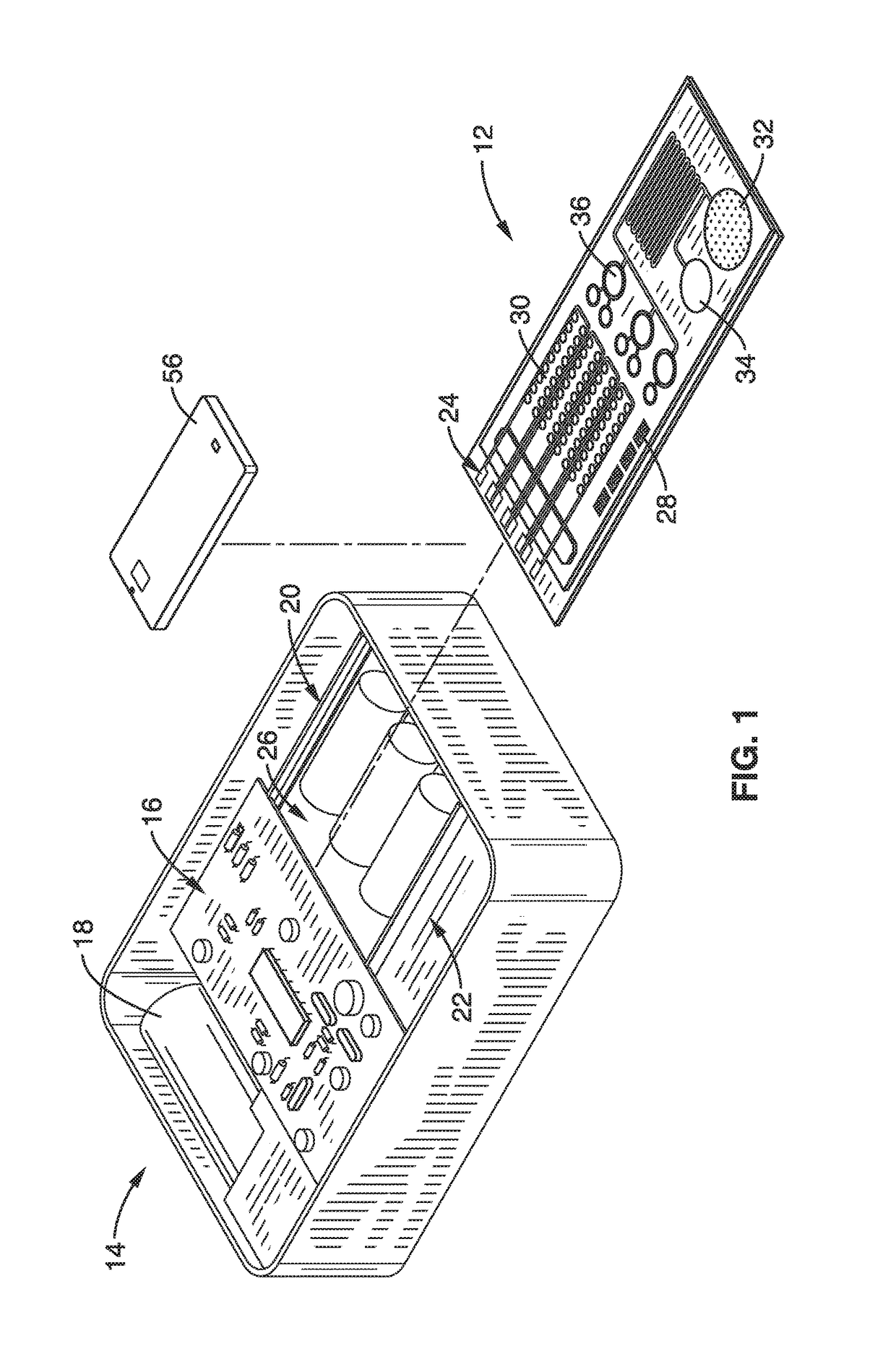Mobile molecular diagnostics system with wireless communication
a molecular diagnostic and wireless communication technology, applied in the field of diagnostic devices and methods, can solve the problems of limited laboratory facilities, process that is not well suited for low-cost field operations, and most systems that have been developed to date have not been truly autonomous, etc., to achieve low cost, simple operation, and low power consumption
- Summary
- Abstract
- Description
- Claims
- Application Information
AI Technical Summary
Benefits of technology
Problems solved by technology
Method used
Image
Examples
example 1
[0070]In order to demonstrate the operational principles of the apparatus and synthesis methods, an apparatus was constructed having the features shown schematically in FIG. 1 with the integrated molecular diagnostic system for the simultaneous detection of protein and nucleic acids and mobile phone-based image acquisition and analysis.
[0071]Plasmonic protein detection was demonstrated using an Apple™ iPhone 4 and wave-guided excitation of gold nanoparticles by LED illumination. A sandwich immunoassay scheme was used for the detection of a specific protein and the secondary antibody was labeled with 40 nm gold nanoparticles. A low cost (˜$4) iPhone microscope was used for higher magnification to capture images of plasmonic protein assay using iPhone 4. Images of the chip of captured proteins using the sandwich immunoassay were analyzed for quantitative analysis.
[0072]The improvement off the limits of detection through further enhancement of plasmonic light scattering with a nanodisk...
example 2
[0074]The functionality of the dark-field smartphone microscope and dark-field illumination based on the evanescent field generated by LED total internal reflection (TIR) were also demonstrated. The smartphone camera was converted to a dark-field microscope by an attachment that consisted of a dark-field illumination and external lens for magnification. An external lens (f=3 mm) was attached and aligned to the smartphone camera to magnify and capture scattering light from nanoparticles. The scattered light at the surface of the observed nanoparticles was collected without any background due to the short penetration depth of evanescent field.
[0075]Dark-field illumination methods were also compared. From a specimen slide populated with gold nanoparticles, SPR scattering images were taken after (a) oblique illumination and (b) LED TIR illumination.
[0076]Unlike oblique dark-field illumination that requires condenser and spider light stop, an evanescent field is used to avoid complexity ...
example 3
[0081]The adaptability of the system to different optical detection schemes was further demonstrated by detecting a wavelength shift by gold nanoparticle aggregation. A bioassay of gold aggregation from biotin-streptavidin interaction was performed and imaged and analyzed with the dark-field smartphone microscope.
[0082]Gold nanoparticles with 80-nm diameters that are coated with biotin exhibit SPR wavelength with a green color. Gold nanoparticles that were 40 nm in diameter that were coated with streptavidin were also prepared and introduced to the first set of 80 nm particles. After introduction of the second particles, the gold nanoparticles start to aggregate due to the strong interaction of biotin-streptavidin. The SPR wavelength of observed particles shifted from green to orange in color indicating the aggregation of gold nanoparticles by biotin-streptavidin interaction.
[0083]Embodiments of the present technology may be described herein with reference to flowchart illustrations...
PUM
| Property | Measurement | Unit |
|---|---|---|
| diameter | aaaaa | aaaaa |
| diameter | aaaaa | aaaaa |
| volume | aaaaa | aaaaa |
Abstract
Description
Claims
Application Information
 Login to View More
Login to View More - R&D
- Intellectual Property
- Life Sciences
- Materials
- Tech Scout
- Unparalleled Data Quality
- Higher Quality Content
- 60% Fewer Hallucinations
Browse by: Latest US Patents, China's latest patents, Technical Efficacy Thesaurus, Application Domain, Technology Topic, Popular Technical Reports.
© 2025 PatSnap. All rights reserved.Legal|Privacy policy|Modern Slavery Act Transparency Statement|Sitemap|About US| Contact US: help@patsnap.com



